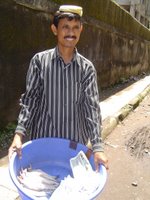I was hanging around Maheshwari Udyan, waiting for the car, when I spotted 10 guys, squatting on the pavement of the busy intersection.

I walked up for a closer look. They're tradesmen, waiting for work to show up. It's an informal marketplace of sorts. The guys closest to the camera are masons. There was a plumber next to them, and three carpenters.
Every morning, come 9:00 a.m., they're here at this corner, and many other corners like this, just waiting. On a good day, a customer will walk up, and the day's work begins. On a bad day, there's endless waiting, with nothing to do but drink tea.

I told my friend Sanjay about the tradesmen I saw. He said to me - "You know what, Deepa, the mobile phone has changed these guys lives."
A painter who was working at Sanjay's house told him that. Earlier, the painter would hang around at a market corner, waiting for clients to come to him. If he wasn't physically there, he'd lose the business. Now, people just call him. He does go to the marketplace, but only so he can give his mobile phone number to more people.
It's stories like these that bring home to me, the real truth of India's telephony revolution.
My tours business functions entirely on mobile phones - my guides have phones, our car drivers have phones, the tourists have phones - how else would we find each other in Bombay's mad traffic?
Below my office at Nariman Point, the sandwichwalla has a mobile phone. "Bas call karo, memsaab, office mein pahuncha denge". Just call, ma'am, we'll bring the sandwich to your office.
My grocer takes orders on his cell phone during his delivery rounds. You have to speak to him to see how this has revolutionized his life. Before the cell phone arrived, he had a phone in his shop, but no one to take calls while he was away delivering goods. With the cell phone he is like one of the Hindu Gods - always around, anytime, anywhere.
The most illiterate of men have figured out SMS texting and how to make it work for them. My driver, a recent migrant from Tamil Nadu, on one particularly clever day, figured out that he could save standard message templates and then send them to me. I caught him explaining it to my sister's driver in what was definitely a smug voice.
In return, my sister's driver who comes from a remote village in Uttar Pradesh, explained how voicemail works. And of course, in the era of lifetime incoming free schemes, they have both mastered the Indispensable Art of the Missed Call.
 On a recent Mumbai tour, we saw this fisherman at Banganga. Guess what he had in his basket?
On a recent Mumbai tour, we saw this fisherman at Banganga. Guess what he had in his basket?








